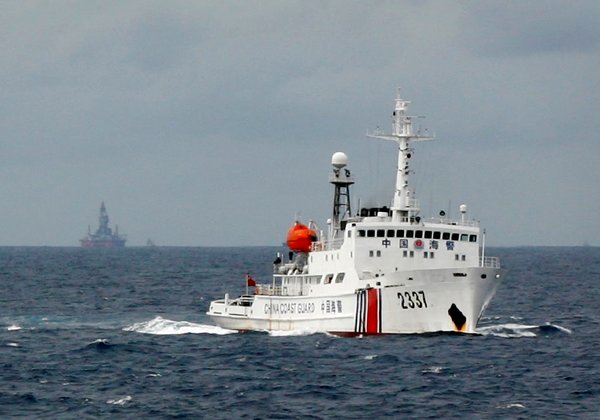HONG KONG — For the past several years, China has been throwing its weight around the South China Sea, a body of water studded with coral reefs that laps at the shores of not only China but also Vietnam, Malaysia, the Philippines, Brunei and Taiwan.
香港——过去几年,中国在南海各处施展拳脚。这片点缀着珊瑚礁的水域,不仅毗邻中国的海岸,也连接着越南、马来西亚、菲律宾、文莱和台湾的海岸。
China has sent ships to stake claims across the area, notably when a flotilla that included the country’s most advanced amphibious assault vessel arrived at James Shoal, 50 miles east of Malaysia’s coast, in 2013.
中国会派出船只,在南海各处宣示主权,特别是2013年,一支中国舰队,携该国最先进的两栖突击舰,抵达了马来西亚海岸以东50英里(约合80公里)处的曾母暗沙。

Much of this muscle-flexing is political. China is a rising power and the South China Sea is a logical place for it to exercise its growing strength. The sea is a vital freight lane, through which a third of global shipping traffic passes. It is also a main focus of geopolitical jockeying for both Beijing and the United States, which has been strengthening its relations with the Philippines, Malaysia and Vietnam.
这样的实力展示,很多都出于政治考虑。中国是一个正在崛起的大国,要找地方展示其不断壮大的实力,南海是一个顺理成章的选择。南海是重要的货运通道,承担了全球船运通行量的三分之一。它也是中美地缘政治角力的一个重要焦点,而美国一直在增进与菲律宾、马来西亚和越南的关系。
There is another reason for China’s interest in the South China Sea: the large quantities of oil and natural gas that might lie below these waters. In May, Beijing made its interest in those resources clear when it sent a drilling rig called Haiyang Shiyou 981 into waters claimed by Vietnam. The rig is owned by China National Offshore Oil Corporation, or Cnooc, the country’s biggest offshore energy producer.
不过,中国之所以对南海感兴趣,还有另外一个原因:这里的海底可能蕴藏着大量的石油和天然气。今年5月,北京把钻井平台“海洋石油981”派到越南宣示主权的海域作业,明确显露了它对这些资源的兴趣。这个钻井平台属于中国海洋石油总公司(简称中海油),该国最大的海上能源生产商。
After the move provoked a standoff with Vietnam, the drilling rig was sent to undisputed waters near China’s island province of Hainan. In September, Cnooc said the rig had discovered a large gas field, which suggested that China had become more proficient at offshore drilling.
此举引发了中越之间的对峙后,钻井平台被移动到中国海南岛附近的一片没有主权争议的水域。9月,中海油宣布,这座钻井平台发现了一个大型天然气田。这表明,中国对海上钻井作业已经变得更加精通。
The United States Energy Information Administration has estimated that 11 billion barrels of oil and 190 trillion cubic feet of natural gas lie below the seabed, including both proven and probable reserves. If those estimates prove correct, the South China Sea would be in the same league as Mexico, a midsize producer, and in the global top 10 in terms of gas.
据美国能源情报署(United States Energy Information Administration)估计,南海的石油储量为110亿桶,天然气为190万亿立方英尺(约合5.4万亿立方米)。这些数字包括已探明的和可能的储量。如果估算无误,南海就会和中等规模的石油出产国墨西哥处在同一个级别上,天然气储量则将跻身全球十强。
The South China Sea is far from virgin territory. But so far, exploration and production of oil and gas have been confined mainly to waters off the coasts of China, Vietnam, Malaysia, Brunei and the Philippines, which form the sea’s perimeter along with Taiwan. The Energy Information Administration estimates that in 2011, South China Sea production by these countries amounted to 1.2 million barrels a day of oil and 3,200 billion cubic feet of natural gas. These numbers are roughly similar to the current crude production of North Dakota and to Saudi Arabia’s annual gas production in 2012.
南海远非一片处女地。但迄今为止,这里的油气勘探和生产主要在中国、越南、马来西亚、文莱和菲律宾的近海水域进行。这些水域和台湾一起,形成了南海的周界线。据美国能源情报署估计,2011年,这些国家在南海出产的石油约为每天120万桶,天然气约为3.2万亿立方英尺。两个数字分别相当于美国北达科他州目前的原油产量,以及沙特阿拉伯2012年的天然气年产量。
Oil and gas exploration has been limited not only by territorial claims but also by typhoons and technological challenges, including limited local ability to drill in deep water. Cnooc has tried to improve its capabilities through the purchase in 2012 of a Canadian company, Nexen, for about $15 billion. Nexen had acquired deep water experience from working in the Gulf of Mexico.
油气勘探活动不仅受到领土主张的限制,也存在台风和技术方面的挑战,比如缺乏足够的深水开采能力。2012年,中海油以大约150亿美元的价格收购加拿大能源企业尼克森(Nexen)。此举是为了努力提升自身能力。尼克森在墨西哥湾作业,已获取了深水钻井经验。
Researchers, too, are exploring deeper waters.
研究人员也正在考察一些较深的水域。
From Jan. 26 through March 30 of this year, the scientific vessel Joides Resolution traveled to the deeper regions in the middle of the South China Sea, where it drilled several core samples as part of the International Ocean Discovery Program’s Expedition 349.
今年1月26日到3月30日,科考船“决心号”(Joides Resolution)前往南海中部的深水区,在那里钻取了几个岩芯样本。这是“国际大洋发现计划”(International Ocean Discovery Program)349航次的一部分内容。
Scientists from 12 countries, including China, the United States, Vietnam, the Philippines and Taiwan, participated. Dr. Li Chun-feng of the State Key Laboratory of Marine Geology at Tongji University in Shanghai served as a director. While emphasizing that the main goals were scientific, Dr. Li said evidence was found that there were “huge” oil and gas reserves beneath the sea.
来自中国、美国、越南、菲律宾和台湾等12个国家和地区的科学家参加了这次航行。李春峰博士来自上海同济大学海洋地质国家重点实验室,是此行的主管之一。在强调这次考察的目的以科学研究为主的同时,李博士也表示,有证据表明,那片水域下可能含有“巨大的”油气储备。
“Our expedition discovered thick organic rich sandstone and shale at the outermost continental margin and the continent-ocean transition zone, further supporting the large potential for oil and gas reserves,” Dr. Li said.
“在最外围的大陆边缘和大陆海洋过渡地带,科考队发现了厚厚的富有机质砂岩和页岩,进一步支持了那里含有大量油气储备的可能性,”李博士说。
New oil and gas pockets are being found. The Canadian oil and gas producer Husky Energy and Cnooc began commercial production at their Liwan natural gas field in the sea’s northern waters in late March.
新的石油和天然气田也在逐渐被发现。加拿大油气生产商赫斯基能源公司(Husky Energy Inc.)与中海油合作,二者在南海北部荔湾开展的天然气田项目于3月下旬投入商业化生产。
The gas, which Husky discovered in 2006, is about 190 miles southeast of Hong Kong and is the largest to date for Husky, which is controlled by the Hong Kong businessman Li Ka-shing. The gas is destined for the Pearl River Delta region, which includes the industrial cities of Shenzhen and Guangzhou.
2006年,这块气田被香港商人李嘉诚(Li Ka-shing)控股的赫斯基公司发现。它位于香港东南约190英里处,是公司迄今为止发现的最大气田。这里生产的天然气将被输送到工业城市深圳和广州所在的珠三角地区。
To reduce the choking air pollution caused by burning coal, China wants to increase the proportion of gas in its overall energy use to 10 percent by 2020 from about 5 percent in 2012.
2012年,天然气约占中国能源总使用量的5%。为了减少燃煤造成的严重大气污染,中国希望到2020年把这个比重提高到10%。
Gas from the South China Sea would fit well with this plan.
来自南海的天然气与这一计划非常吻合。













